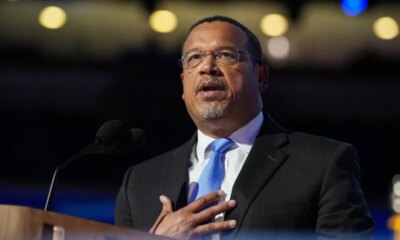New Hampshire
Tim Walz makes sudden schedule change amid VP buzz

In a move that has intensified speculation about his potential selection as Vice President Kamala Harris’ running mate, Minnesota Governor Tim Walz has reportedly canceled his planned trip to New Hampshire this weekend.
President Joe Biden dropped out of the 2024 presidential race on July 21 following weeks of interparty fighting among Democrats on whether he should pass the torch to the next generation after his debate fiasco against Donald Trump in late June in Atlanta. Biden also endorsed Harris the day he withdrew from the race and she is now the presumptive Democratic presidential nominee.
The sudden change in Walz’s schedule comes as Harris is reportedly in the final stages of vetting candidates in her search for a running mate.
CNN senior reporter Edward-Isaac Dovere wrote on X, formerly Twitter, about Walz’s change in travel plans: “A little more veepstakes NEWS: from Tim Walz’s spokesman: ‘The governor’s schedule has changed and he is no longer traveling to New Hampshire this weekend.’”
A little more veepstakes NEWS: from Tim Walz’s spokesman:
“The governor’s schedule has changed and he is no longer traveling to New Hampshire this weekend.”
— Edward-Isaac Dovere (@IsaacDovere) August 3, 2024
Harris is expected to meet with her vetting team today for a series of in-depth presentations on each of the finalists. These briefings, lasting between 60 to 90 minutes each, are designed to provide Harris with comprehensive information on the candidates’ backgrounds, qualifications, and potential impact on the ticket.
The list of finalists reportedly includes Pennsylvania Governor Josh Shapiro, Kentucky Governor Andy Beshear, Arizona Senator Mark Kelly, Transportation Secretary Pete Buttigieg, and Illinois Governor J.B. Pritzker, alongside Walz.
The presentations may result in a narrowing of the field, with Harris expected to conduct final interviews, possibly in-person on Sunday, according to CNN.
Newsweek has contacted the Harris campaign and Walz’s press office via email on Saturday for comment.
AFP/STEPHEN MATUREN
Former U.S. Attorney General Eric Holder, whose law firm is conducting the vetting process, was seen arriving at the Naval Observatory on Saturday morning, underscoring the high-stakes nature of these deliberations.
Walz, a former high school teacher and football coach with a 24-year career in the Army National Guard, brings a unique blend of experiences to the table. As a congressman, he represented a deep-red district in Minnesota, demonstrating an ability to appeal to voters across the political spectrum. His background in education, military service, and agriculture could potentially resonate with voters in key battleground states, particularly in the Midwest.
In a recent op-ed for Newsweek, former Representative Tim Ryan, an Ohio Democrat, made a case for Walz as Harris’ running mate. Ryan emphasized the importance of selecting a candidate who can connect with working-class voters, particularly in the Rust Belt. He highlighted Walz’s understanding of issues critical to Midwestern voters, such as job creation, health care access, and education.
The timing of Walz’s schedule change is particularly noteworthy, mirroring a similar move by Shapiro who recently canceled a fundraising trip to the Hamptons in New York. These parallel developments have intensified the buzz around both governors as potential VP picks.
Harris’ top consideration in selecting a running mate is reportedly electability. The choice will not only impact the campaign’s strategy, but also signal the Democratic Party’s priorities and vision for the future.
With Harris expected to announce her running mate before a planned campaign rally in Philadelphia on Tuesday, the political world is on high alert for any further schedule changes or announcements from the potential VP candidates.

New Hampshire
5-year-old injured in New Year’s day Manchester, New Hampshire apartment building fire dies

The child who was injured during a New Year’s Day apartment building fire in Manchester, New Hampshire has died, the New Hampshire State Fire Marshal announced on Saturday.
The 5-year-old girl had been found unresponsive in a fourth-floor bedroom by firefighters. She was rushed to a Boston hospital in critical condition and passed on Wednesday. The Massachusetts Office of the Chief Medical Examiner has performed an autopsy to determine her cause of death.
The fire began just 30 minutes after midnight on Union Street. The flames raged on the third and fourth floors before spreading to the roof. One man was killed in the fire. He was identified as 70-year-old Thomas J. Casey, and his cause of death was determined to be smoke inhalation, according to the medical examiner.
One woman was rushed to a Boston hospital in critical condition. Five other people received serious injuries and were hospitalized. All the victims have since been discharged, according to the fire marshal.
Residents could be seen waiting in windows and on balconies for firefighters to rescue them.
“I kicked into high gear. I got my family rallied up. My son, my daughter, my wife. And I tried to find a way to get down safely off of one of the railings by trying to slide down one of the poles. But that didn’t work out,” said resident Jonathan Barrett.
Fire investigators believe the fire is not suspicious and started in a third-floor bedroom. The building did not have a sprinkler system but did have an operational fire alarm, the fire marshal said.
Around 10 families were displaced by the fire and are receiving help from the Red Cross. Around 50 people lived in the building.
New Hampshire
New Hampshire services respond to 7-car crash

SPRINGFIELD, N.H. (ABC22/FOX44) – After an icy morning on Interstate 89 that saw multiple cars in a crash in Springfield, New Hampshire, responders say that they are thankful that only one person sustained injuries.
According to Springfield Fire Rescue, they originally were called at 7:40 a.m. on Friday for a reported two-car crash between Exits 12A and 13 – but arrived to find 7 vehicles involved, including 6 off the road.
According to authorities, all of the occupants of the cars were able to get themselves out and only one needed to be taken to the hospital. Their injuries were reported to be non-life-threatening.
“Springfield Fire Rescue would like to take this opportunity to remind everyone to slow down and move over when emergency vehicles are in the roadway. The area where this incident occurred was very icy and we witnessed several other vehicles almost lose control when they entered the scene at too great a speed.”
Responders from New London, Enfield, and Springfield, as well as NH State Police, helped respond to the incident and clear the vehicles from the road, as well as to treat the ice to make the road safe.
New Hampshire
Man killed in NH snowmobile crash

An Alton man is dead after a snowmobile crash in New Hampshire’s North Country Thursday afternoon.
The New Hampshire Department of Fish and Game says 63-year-old Bradford Jones was attempting to negotiate a left hand turn on Corridor Trail 5 in Colebrook when he lost control of his snowmobile, struck multiple trees off the side of the trail and was thrown from the vehicle shortly before 3:30 p.m.
Jones was riding with another snowmobiler, who was in the lead at the time of the crash, according to the agency. Once the other man realized Jones was no longer behind him, he turned around and traveled back where he found Jones significantly injured, lying off the trail beside his damaged snowmobile.
The man immediately rendered aid to Jones and called 911 for assistance, NH Fish and Game said. The Colebrook Fire Department used their rescue tracked all terrain vehicle and a specialized off road machine to transport first responders across about a mile of trail to the crash scene.
Once there, a conservation officer and 45th Parallel EMS staff attempted lifesaving measures for approximately an hour, but Jones ultimately died from his injuries at the scene of the crash, officials said.
The crash remains under investigation, but conservation officers are considering speed for the existing trail conditions to have been a primary factor in this deadly incident.
-

 Detroit, MI1 week ago
Detroit, MI1 week ago2 hospitalized after shooting on Lodge Freeway in Detroit
-

 Technology5 days ago
Technology5 days agoPower bank feature creep is out of control
-

 Dallas, TX2 days ago
Dallas, TX2 days agoAnti-ICE protest outside Dallas City Hall follows deadly shooting in Minneapolis
-

 Dallas, TX6 days ago
Dallas, TX6 days agoDefensive coordinator candidates who could improve Cowboys’ brutal secondary in 2026
-

 Delaware2 days ago
Delaware2 days agoMERR responds to dead humpback whale washed up near Bethany Beach
-

 Iowa4 days ago
Iowa4 days agoPat McAfee praises Audi Crooks, plays hype song for Iowa State star
-

 Health7 days ago
Health7 days agoViral New Year reset routine is helping people adopt healthier habits
-

 Nebraska4 days ago
Nebraska4 days agoOregon State LB transfer Dexter Foster commits to Nebraska





















